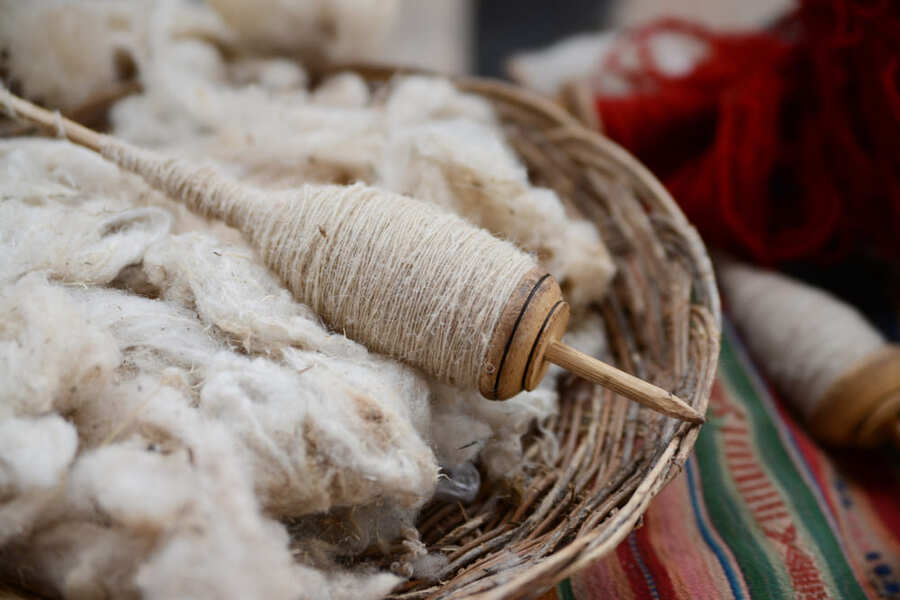Soul of Your Wool Rugs, Wool is the primary raw material for handmade rugs. The wool rug weavers use wool in the weft, wrap, and knots of their handmade rugs. They also use natural minerals and herbs to produce dyes.
In other words, without high-grade wool, there would be no excellent handmade rugs. This article tells you why wool is so important in the rug weaving industry. Plus, how handmade wool rugs benefit from wool’s unique features.
Fine Wool Rug
There are three main categories of fine wool. The finest qualities of wool come from sheep, primarily the Merino sheep. Wool rug weavers use it for high-quality, soft handling fabrics and knitting yarns. The world’s leading fashion houses highly value this type of wool.
Medium Wool Rug
A wide range of fine and coarse wool comes from mixing one breed of sheep with another. Many of these have become established mixed breeds – such as Corriedale. The livestock industry breeds them in large numbers. Rug artisans use medium wool in a variety of woven cloths, knitting yarns, and furnishings.
Coarse Wool Rug
Some sheep breeds produce very coarse wool. These sheep are dual-purpose breeds, farmed with equal emphasis on meat and wool. Romney sheep produces long and medium-luster wool. The wool is beneficial for rugs because of its strength and durability.
Wool is sheared by scissors from live sheep or a knife from those dead in a tannery. It is good to know that the high-grade wool in Persian wool rugs comes from live sheep. That is because the shortness of tannery wool makes it improper for rug production.

Characteristics of Top-grade Wool
The wool’s quality depends on its delicacy and thickness, length, strength, smoothness and natural color. What’s more, fine wool must have adaptation quality in the dyeing process and the proper tension-bearing in each string.
Not all the wool of a sheep’s body is similar in these characteristics. Wool from the shoulders is best, after that, wool from the chest and lastly, wool from the legs and underbelly.
To explain these characteristics, consider that thinner strings have better quality.
Nowadays, general standards of strings’ thickness are:
– The best quality should have less than 30 microns thickness of each string;.
– The thickness of the second grade is between 30 to 35 microns;.
– The third grade has around 35 to 40 microns thickness;
– And, the wool with more than 40-micron thickness is fourth grade and has the lowest quality.
Strings of wool should be as long as possible. On the average, the first-grade wool strings’ length should not be less than 7.5 cm.
The strength of the wool’s string depends on the nourishment of the sheep. If a sheep does not have good nutrition, then the wool will be dry and fragile.

Smoother wool is suitable for rugs, and curly wool is not. For smoothing curly wool, some chemical processes are available. But these chemicals are expensive and harm the excellence and durability of wool.
Naturally, wool colors are white, yellow, gray, brown, and black. White wool is the best and most expensive because it converts to any color without needing extra chemical processing.
The absorbing ability of wool is related to different factors. One of them is the primary color of the wool itself, as mentioned before. The other one is the wool’s greasiness which should be decreased by constant washing. Moreover, the thickness of each string is important since the thinner the wool has more stability and dyeing ability.
According to these factors, the best quality wool is white wool (25% pollution at maximum). It should also have an average of 30 microns thickness and not less than 7.5 cm length of each string.
The quality of products at the end is entirely dependent on the quality of their raw materials at the beginning. That is why all large wool rug weaving companies employ agents to purchase the best raw materials. Notably, even from the most remote villages of Iran.
Different types of Wool in Iran
Sheep husbandry is common all around Iran. Kurdish, Sarakhsi, Baluchi sheep in Khorasan have top-quality wool. The wool of these breeds is around 65 to 70%. About 65 to 70% of their wool is in white tonality.
In the Azerbaijan province, some other breeds are common, like Maku, Hergi, and Moqan. Among these, Maku is the best. The wool of Azerbaijani breeds is around 35 to 55%, and 35 to 55% of their wool is white.
In Markazi province sheep breeds are: Arab, Mahabad, Bakhtiari, Kaku and Farahan. Mahabad is the best of them. Their wool is around 70% to 75%, and they have 30 to 40% white tonality. Soul of Your Wool Rugs.
Kurdistan and Kermanshah sheep are Lori breeds. Their wool is around 45 to 55%, and also about 70 to 85% of their wool is white.
In Khuzestan, Fars and Kerman sheep have Arab-Lori and Qashqai Breeds. Their wool is around 50 to 55%, and 65 to 70% of their wool has white color.
In Mazandaran and Gilan provinces, The Zol breed is more common. Their wool is around 50 to 55%, and only 20 to 30% of their wool is white.
Generally, the Mazandaran and Gilan wool are among the most inferior ones considering the required quality. However, some of the Mazandarani wool rugs are very well-known, like Kelardasht rugs that are unique and famous worldwide.

Your home décor and your feet will thank you after you chose to get the wool rugs collection! If you’re interested in these delicate works of fine art, we have a top-quality collection of them, waiting to be discovered by you! Head over to our website or Louisville, KY Rug Store today and surround yourself with these irresistible rugs. Soul of Your Wool Rugs.

